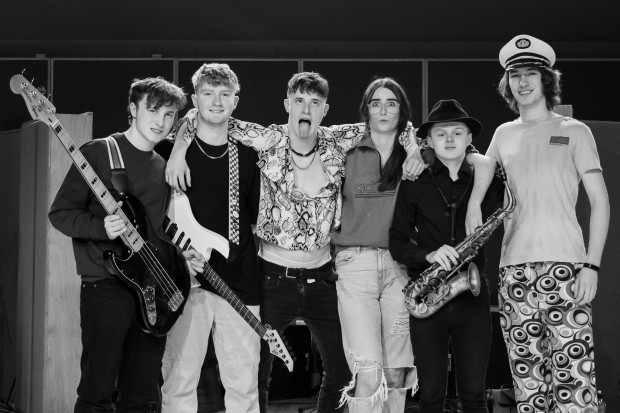
Johnny Óg Connolly
Tracing a Life's Path
An Cosán Draíochta. The words mean ‘The magical path’. When Johnny Connolly, the late, renowned melodeon player, used them in the title of a reel, he was thinking of the path between the island on which he was born – Inis Bearacháin – and the coast of Conamara. The path could be walked, but only at low tide.
Connolly’s son, Johnny Óg, is himself a melodeon and accordion player of no little skill. In memory of his father, who passed away in 2019, he has written a new performance suite, also called An Cosán Draíochta. Commissioned by Stiúideo Cuan, the new music and arts venue in An Spidéal, and directed by Darach Mac Con Iomaire, it’s a night of story, song, music and dance, and the second last night of its nationwide tour took place on Friday 11 November at Solstice Arts Centre, Navan.
Walking a path
The framing device, as it were, of the suite is a story recited of Connolly’s first melodeon, and of a journey not taken along the cosán draíochta. Singer and actor Áine Ní Dhroighneáin walked a path across the front of the stage several times as she told the story, or recited poems, or sang, while behind her the musicians played: flanking Connolly were Clíodhna Ní Choisdealbha and Ciara Ní Bhriain, the former playing banjo, bouzouki and tenor guitar, and the latter fiddle and viola, with guitarist Pádraig Ó Dubhghaill and percussionist Jim Higgins sitting on the outside edges. Partway through the performance they were joined by dancer Seosamh Ó Neachtain. Behind the musicians, three charcoal portraits of Connolly Sr and a number of household standing lamps.
This is a work both mournful and cathartic. The idea of a magical path informs so much of the journey of the performance. Several times, Connolly returns to a slow tune named after Inis Bearacháin, and each time the music finds a unique path to escape to a brighter tune. This has often been my experience of concerts of traditional music, especially more formal ones like this; darker moods are met with sincerity and understanding, but are never made to seem permanent. You mourn, and then you live.
Melodic flow
Every word of the performance was in Irish. My own grasp of the language is of a poor enough standard that I wasn’t able to understand much of the words beyond the injunction to turn off our phones and note the fire exits. (Luckily my neighbours in the audience were Irish-speakers, able to fill in for me a sketch of the story.) There’s an odd sensation in hearing a language spoken that you understand only a little. The familiarity of the syllabic sounds creates a melodic flow of its own; fleeting recognised words and phrases creating associative links and mental images that flicker and vanish as the words continue.
There was one particularly dazzling moment in which music and spoken text were married in as perfect a union as I have heard in any language. Reciting the poem ‘Trí Nithe’ by Máirtín Ó Direáin with accompaniment from Ní Choisdealbha on tenor guitar – a beautiful-sounding instrument I don’t believe I’d heard before, with a crystalline, almost harp-like timbre – Ní Droighneáin’s voice was clear and relaxed. The lilting, childlike 6/8 sway felt utterly natural to both words and accompaniment, and at no point felt either rushed or stretched.
In fact the performance never veered into very fast tempi; exhilaration in faster passages, when it came, was a result of tight rhythmical playing and by beautiful tone colour. As the focal point of the ensemble, emotionally as well as musically, Johnny Óg Connolly’s playing was passionate in slower tunes and agile in quicker ones. But the joy in music making of the group was palpable; as Connolly played the jigs ‘Poirt Inis Bearacháin’ nos. 3 and 4, Ní Choisdealbha watched with a smile. In their own leading passages, Ní Choisdealbha and Ní Bhriain proved as nimble as Connolly’s, with the minor-key reel ‘Scaipeadh Aigne’ (‘Scattered mind’ – a reference to Connolly Sr’s Alzheimer’s) having been particularly striking, while Ó Dubhgaill and Higgins kept a solid rhythmic foundation. Likewise Ó Neachtain’s hypnotic footwork, at times seeming to float across the boards.
Theatricality
There was a theatricality to the performance, always delicately managed and, like the musical performances, skilful but never showy. The little movement that occurred on stage was usually as Ní Dhroighneáin crossed it, or as Ó Neachtain danced. But it was just enough that when they joined each other to dance a waltz (‘Válsa Johnny & Patricia’) it felt natural and integrated.
When the musicians switched instruments, they generally did so as a group – banjo switching to tenor guitar at the same time as fiddle to viola and snare drum to bodhrán, meaning that the texture of the whole group changed rather than a new sound emanating from within it.
It seems likely that when Johnny Óg Connolly conceived this project, the cosán draíochta referred as much to the path of his father’s life, and to the narrative path of story and music as they are experienced. And in tracing those paths together, he has created a tribute to his father that is touching, fitting, and cathartic.
Visit https://johnnyogconnolly.com and https://www.stiuideocuan.ie.
Subscribe to our newsletter.
Published on 17 November 2022
Brendan Finan is a teacher and writer. Visit www.brendanfinan.net.















